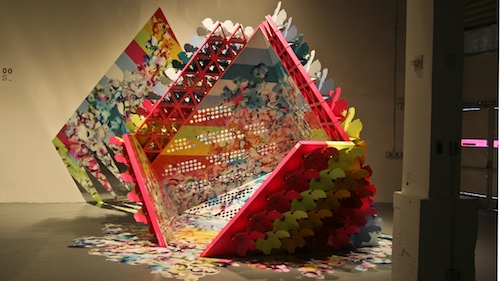The architecture exhibition A New Sculpturalism: Contemporary Architecture from Southern California at the Los Angeles’ Museum of Contemporary Art is a showcase of what has been going on in the last quarter of a century. The show, born after a hard delivery and intensive care, remains stable but under observation. For readers who may want to know more about the behind-the-scenes that preceded it, Christopher Hawthorne’s article in the Los Angeles Times of June 30, 2013 is a good source.
So why is this show important?
1. It raises awareness about some of the dreams and struggles architects go through during the process of making architecture. Notebooks, drawings and models illustrate their intentions; photographs illustrate built realities. Available on line, MOCATV also brings up interviews with some of the participating architects. Obviously “the real thing”- architecture – can only be appreciated by walking through the space itself and experiencing the scale, light, forms and textures. But for people outside of the profession, the exhibition is a good “jump-start” into the complex world of architecture.
2. The show demonstrates how rebels of the 1980’s who are now part of the establishment continue to challenge the formal agenda of architecture.
3. The younger generation has passions that defeat easy labeling. Today’s young architects, while less ideological than their predecessors, must confront colossal problems: urban chaos, sclerotic regulations and bureaucracy, population growth, sustainability, climate change and rapidly evolving technology.
While the computer is a tool without which many of the projects would be difficult to build within a budget straightjacket, and 3D renderings allow architects to explore perceptions before building, models allow them to have the sculptor’s approach of moving around the object. Except that… architectural models are not sculptures. In this sense, the exhibition’s use of the term “sculpturalism” is inappropriate and misleading.
Since the emergence of Italian Mannerism in the early 16th Century, architecture has gone through many “isms:” Constructivism, Rationalism, Expressionism, Brutalism, Post-modernism and De-constructivism, to name a few. In each case the term provided a concept that defined a certain philosophy and style.
“Sculpturalism” tries to pigeonhole many different directions that do not always connect. Does it mean “formalism?” Does it mean “architecture-as-art?” Drawings and models are not “art objects” to be contemplated and evaluated as an end product. There are tools to create spaces in which the only scale of measurement is the human.
The exhibition positions itself within the framework of Southern California; yet despite the benefits seems self-centered and disconnected from a world that is creatively moving forward (take for instance China, South Korea, and Dubai.) With that in mind, the main achievement of the exhibition is what it offers to the general public: a glimpse into a world where an “ocean of merchandise” (to quote Wright) often suffices for “architecture.”

